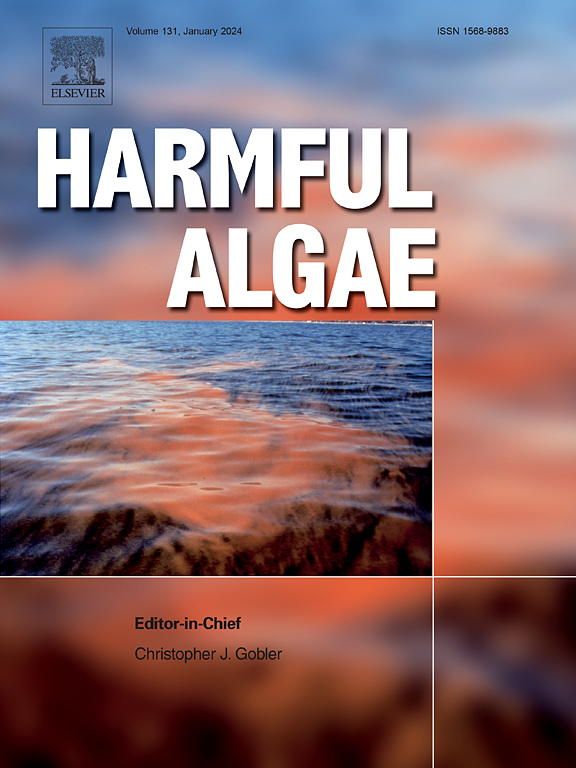控制蓝藻华与铁添加可以有利于耐应力的有毒物种
IF 4.5
1区 生物学
Q1 MARINE & FRESHWATER BIOLOGY
引用次数: 0
摘要
利用湖内措施控制湖内磷负荷是几十年来研究的课题。虽然铁(Fe)在沉淀P方面是有效的,但由于其氧化还原敏感性,对它的测试较少。铁在控制磷有效性和下沉蓝藻华方面的有效性与其作为浮游植物生长的营养物质的功能形成对比。铁的这两种作用分别在一个常年蓝藻爆发的浅湖中放置36天的围栏中进行了测试,并在缺铁的Raphidiopsis raciborskii的实验室实验中进行了测试。以湖水的总磷(TP)为基础,分别以30:1 (16 mg Fe L-1)和90:1 (47 mg Fe L-1) (Fe:P摩尔)的FeCl3剂量对蓝藻种群进行磷沉淀和絮凝沉降。每个处理使用三个围场和三个不添加FeCl3的围场(对照)。90:1的处理使以浮藻菌为主的蓝藻生物量下降了50倍,浊度、叶绿素a和总磷显著降低,pH值没有持续下降,达到中营养型。然而,在第3天至第14天之间发现了鼠型恙螨恢复的迹象。在实验室实验中,在硝酸盐有效度(+N)和氮固定(-N)条件下生长的缺铁R. raciborskii MVCC19暴露于5种FeCl3浓度(0 ~ 17.9 (10:1)mg Fe- 1 (Fe:P摩尔)。对高铁的耐受性是培养基的7倍,对低氮的耐受性降低。此外,在+N条件下,猪尾鼠的铁含量较低,而在n2固定条件下,猪尾鼠对铁的需求量较高。毛状体长度的增加表明对胁迫的抵抗,在-N条件下毛状体较短。因此,要想有效地治理鼠纹田径病,还需要对湖泊氮进行额外的控制。我们的研究结果指出了铁的双重作用,在再少营养化情景下,耐应力物种可能成为优势。本文章由计算机程序翻译,如有差异,请以英文原文为准。

Control of cyanobacterial blooms with iron addition can favor stress-tolerant toxic species
The control of internal phosphorus (P) load by in-lake measures has been the subject of decades of research. Although iron (Fe) is effective in precipitating P, it has been less tested due to its redox sensitivity. The effectiveness of Fe in controlling P availability and sinking cyanobacterial blooms contrasts to its function as a nutrient for phytoplankton growth. Both roles of Fe were tested in enclosures placed for 36 days in a shallow lake with a perennial cyanobacterial bloom, and in laboratory experiments with Fe-deficient Raphidiopsis raciborskii. Based on total P (TP) of lake water, we applied two doses of FeCl3, corresponding to 30:1 (16 mg Fe L-1) and 90:1 (47 mg Fe L-1) (Fe:P molar), to cause P precipitation, and flocculation and sinking of cyanobacterial populations. Three enclosures per treatment and three without FeCl3 additions (control) were used. The 90:1 treatment sank the main cyanobacterial biomass (50-fold) dominated by Planktothrix agardhii, with a significant decrease in turbidity, chlorophyll a and TP, without lasting decrease in pH, and achieved mesotrophic-like conditions. However, signs of recovery of R. raciborskii were detected between days 3 and 14. In laboratory experiments, Fe-deficient R. raciborskii MVCC19 grown under nitrate availability (+N) and N2-fixation (–N) were exposed to five FeCl3 concentrations from 0 to 17.9 (10:1) mg Fe L-1 (Fe:P molar). A remarkable tolerance to high Fe was found at concentrations 7-fold higher than culture medium and decreased under –N. Also R. raciborskii stood low Fe levels in +N and exhibited higher Fe requirements under N2-fixation. The increase in trichome length suggests resistance to the stressor, with shorter trichomes in –N. Therefore, effective management of R. raciborskii requires additional control of N in lakes. Our results point out the double role of Fe applications in which stress-tolerant species may become dominant under the reoligotrophication scenario.
求助全文
通过发布文献求助,成功后即可免费获取论文全文。
去求助
来源期刊

Harmful Algae
生物-海洋与淡水生物学
CiteScore
12.50
自引率
15.20%
发文量
122
审稿时长
7.5 months
期刊介绍:
This journal provides a forum to promote knowledge of harmful microalgae and macroalgae, including cyanobacteria, as well as monitoring, management and control of these organisms.
 求助内容:
求助内容: 应助结果提醒方式:
应助结果提醒方式:


